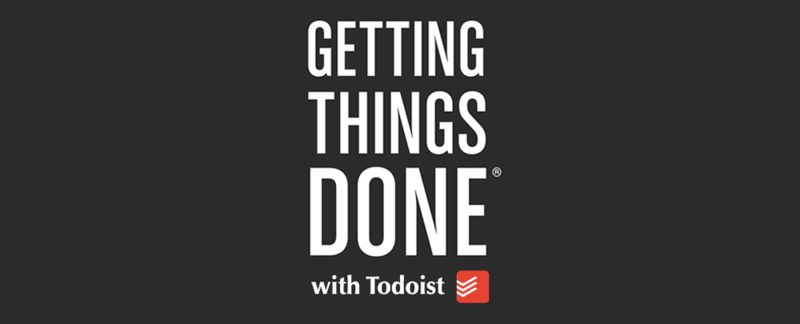
The true goal of productivity is to get your most important shit done. It’s about completing the tasks that drive value to your projects, business and life.
In order to get tasks, projects and important goals done, you have to be organized. You have to deal with a world of too much information and endless distractions. You need to process, priorize and execute.
I’ve read a lot of books about work and productivity, but arguably the most influential on me (and a lot of other high functioning executives and entrepreneurs) is David Allen’s “Getting Things Done.” It was a game changer for me personally. It’s a book I highly recommend and have gifted the most.
Like a lot of modern digital worker, I have struggled with all of the work and information I have to deal with. Figuring out your priorities and managing all of the stuff is hard. This is situation is the challenge of most modern digital workers, as Allen points out. His book and methodology pushed me get dominion over the “stuff” and create a system to get it out of my head and into a process.
The GTD system leads us to a better “product” of productivity: getting things done or, to put it another way, completed tasks, project and goals. The point is to get tasks done and projects advanced. In turn, this product of productivity (completed tasks) become a great measurement of your productivity too.
When it comes to implementing David Allen’s “Getting Things Done” or GTD methodology, there are a lot of options. The book itself is fairly agnostic about a preferred tool and approach. Allen’s website lists several options from software (like Wunderlist, OneNote and Evernote) to physical notebooks. Most of the book looks at a non-digital approach of using paper, folders, file cabinets, and a calendar.
For the more digitally inclined, there are a lot options for managing your checklist, todo list and projects. A comprehensive review of checklist and task managers is beyond this post. Personally, in my first adaptation of GTD I used Evernote. By adapting Evernote, a flexible tool for handling notes and media, I created my own GTD task manager. For more on that, see “The GTD Way: Managing Your Tasks and Information with Evernote”.
About a year ago, I decided to switch to Todoist, a multiplatform task and project manager. It’s a tool with a bent towards GTD but also general good piece of software for handling tasks, projects and goals. My impetus for switching was tracking. My GTD Evernote System worked great, but as a slightly obsessed self-tracker, I wanted more data.
In this post we will look at David Allen’s “Getting Things Done” methodology and how it applies to getting things done using Todoist. We will talk about a few best practices for using Todoist as your primary tool for task and project management.
Hopefully it can help you get better at mastering all of the stuff and focus on the “getting things done” part.
In the conclusion (and in more detail in a later post), we will dig into all of the tracking data on tasks and how you can use this to measure your productivity from small tasks to complex, multistep projects.
The Core Tenants of “Getting Things Done” (GTD)
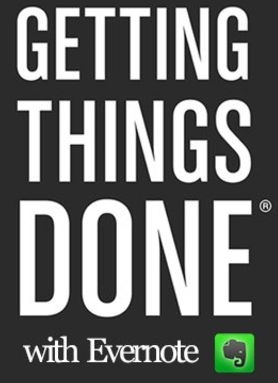
“Getting Things Done” or GTD is the Productivity Philosophy originated by David Allen. In his book, Allen lays out his method, some basic principles and processes that allows us to handle all of modern life’s tasks and information. The GTD method lets you organize your TODOs, priorities, knowledge, and schedule so that everything becomes manageable. You put things in their place and mentally follow through on what needs to be next. His ultimate aim is to help you work in a productively “Zen” fashion.
To summarize “Getting Things Done”:
Put simply, GTD is a method for organizing your to-dos, priorities, and your schedule in a way that makes them all manageable. One of GTD’s biggest benefits is that it makes it easy to see what you have on your plate and choose what to work on next. It also has a strong emphasis on getting your to-dos out of your head and into a system you can refer to. This clears your mind of any mental distractions that will keep you from working efficiently. (Source: Productivity 101: A Primer to the Getting Things Done (GTD) Philosophy)
Its five tenants or steps are:
- Capture everything: This means you need to get everything out of your head and into a tool, whether digital or paper or organizational.
- Clarify the Actionable Steps: Things become unmanageable when you don’t know what to do next. So, take complicated projects like “Plan Trip” and break it up into a series of actionable steps. With everything that is a task, I do this by ensuring I write down what the next action is. By having an action to do next, a large task suddenly has a first few steps.
- Organize those actionable items by category and priority: Your organizational system, task tool or paper system should allow you to put things into proper categories, i.e. home tasks, work tasks, project-specific tasks, etc. Similarly you need a way order or prioritize your actionable items. A good way to do this is to assign due dates and set reminders for followups. In this step, you taking care of your system, calendar, todo list, etc.
- Reflect on your to-do list: This is the step where you pause before you start working. You look at your todo’s to see what your next action should be. You should have an idea on how much time or energy these tasks will take and can figure out what fits best with your availability.
- Engage and get to work: Allen doesn’t go into much depth on how you choose what to work on since, as he admits, once you have captured, clarified, organized and reflected, you tend to know what you should do next. A good system makes it easy to know what to work on and when. It’s now time to get to work.
To put it in a sentence, GTD encourages you to deal with the unprocessed “stuff” and put it in a well-organized place with a clear next step, before focusing and engaging in your work tasks.
Evernote and GTD: Why I Switched to Todoist
After my initial reading of Allen’s book, I started to implement different aspects of the system. Initially it was handling email. I got better and clarifying an email as a task, a piece of information or an undefined. This simple mental process made it easy to gain a much better mental state around my Inbox.
My next step in implementing GTD was leveraging Evernote. Evernote is still my favorite tool for handling all of my digital information from articles to notes to drafts to most media too. When it came managing tasks, Evernote can work great too. As I wrote up in “The GTD Way: Managing Your Tasks and Information with Evernote”, Evernote can be used to capture of all of the unprocessed junk and to turn that into knowledge storage or tasks. By leveraging Evernote’s tag structure and notebooks, it’s easy to keep everything organized and flowing.
In the end, applying many of GTD principles help me to improve my work and personal life. I was less stressed and felt in better control of an increasing work load. While it wasn’t the only factor, I was happier too.
I love Evernote and still do. There is something quite powerful about having everything in one system from initial unprocessed and notes to upcoming tasks and archived copy of what happened. Equally Evernote works great to store articles and book notes. That said, there were a couple issues in my GTD Evernote system.
Firstly, Evernote is not an optimized task manager tool. It is a tool for collecting and organizing information. As a task tool, Evernote offers checkboxes which I use for marking sub-tasks and aspects to work on, and it has reminders which are for time-sensitive tasks. But overall, it’s user experience and user interface is about text processing, not task processing.
Secondly, Evernote doesn’t offer internal stats. You can’t see your usage on which notes and word count changes. Premium version offers version control, which is a nice add-on, but essentially you can’t pull out a simple display of which tasks you completed over a period. It didn’t give me a measuring stick on my week.
Evernote remains a core player in my productivity toolkit. I still use it as my CRM, my article reader, note taker, life planner, goal tracker and writing journal. But it’s no longer my principle task management tool.
Not having the stats and improving handling an ever growing list of projects and tasks lead me to a more dedicated task management tools, like Todoist.
Todoist: A “Getting Things Done” Task Management Tool
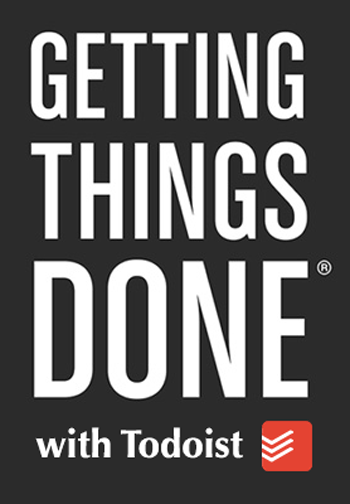
Ultimately the goal of task management tools is to get better about handling all of the things we need to get done (without going crazy!).
If leveraged correctly, these same tools can provide behavioral tools to help you work and live better, to get better at completing complex projects and pursuit long-term goals. Equally, a good task management tool can provide a lot of interesting data and provide a way to answer some of these questions.
There are a lot tools out there for task management. Some are simple checklist apps like Wunderlist or Google’s Tasks, while others are much more full-featured approaches to productivity and project management. A lot of tools are for collaboration and team workflows. It seems like everyday there is some new software or app to try in the space. I’ve even got my own list of “Tools for Productive Awesome-ness.”
For a long time I resisted trying to switch task management systems, in spite of strong recommendations from friends using Omnifocus, Todoist, and a few others. My do-it-yourself “GTD Evernote” system was working for me. Evernote had become a very reliable task manager for me. I had no real complaints, besides some performance problems, not having higher-level analytics and the ability to oversee my week in terms of completed tasks.
But as I got more and more into self-tracking and personal data, I started to realize the value of high quality tools that offer you data points to understand your usage. In fact, I’d argue this is a critical component in the tools and services I use: I want my data. I want–err expect–at least the ability to export what I did on the platform, service or app.
So, in view of getting more data and tracking about my tasks, I switched to Todoist. It wasn’t easy changing tools, since I had established routines that worked, but I gave it a a week.
After a week of usage, here was my reaction: “After doing some review and thought, I see that it’s a superior system and that it will be a more seamless experience for task management. I also like the idea of a dedicated task manager and leave Evernote to do other things like be my digital file cabinet and be my writing book and my habit tracking journal. These are all of Evernote’s strengths.”
Since using Todoist several more months, I have come to see Todoist as broader approach to optimizing all of my tasks as well as a way to break down projects into a series of steps. Similarly I’ve been able to adapt Todoist to provide a good system for adding, tracking, and starting on my bigger, long-term goals.
Basics of Todoist: Projects, Tasks and Due Dates
Todoist has a number of great guides for usage and getting started. In particular I recommend, “A Comprensive Guide to Using Todoist”.
Todoist has a number of features and organizational principles. First off, you’ll want to create a “project” for a certain area or focus, like “Writing” or “Digital Marketing.” Once you have a project, you then create tasks.
You can organize and prioritize your tasks in a number of ways but the main engine of organizing is due dates. A due date can be like tomorrow, on March 30, etc. It can also function as repeat tasks with due dates like every Tuesday or once a month, etc.

The other way to organize tasks is by grouping them. So you can have a top-level task like “Write a Blog Post of X” and then a series of smaller tasks below them. By grouping and organizing them in order, it’s easy to follow what’s important next.
Once you are done with a task, you simply check it off.
Todoist keeps a record of your completed tasks and uses that to calculate your karma score, which is their simple tracking and gamification method. You also hae access to a full history and log of your completed tasks. This can be leveraged to know in a simple way how many tasks you are getting done as well as the ability to craft this into great task tracking. We will go more into this in later post.
The key to GTD is capturing everything into a system and avoiding letting your brain work to remember (and stress out) everything. All of my current and long-term future projects, tasks and goals now go into Todoist. Todoist lets me keep tasks and goals in one-place and each day and week I’m able to schedule my tasks.
Previously my main method around priority was that I’d work from high priority tasks to then work on important but less critical tasks. Everything else was later or someday. Todoist has a similar optic but it’s main focus is on scheduling task for each day. This allows a largely amount of flexibility and makes it easier for me to manage multiple personal and business project. I really love the scheduling aspect.
Getting It Out of Your Head and Into Todoist
To borrow a phrase from GTD, you need to get all of the stuff out of your head and into a system. If it’s a piece of information to store it goes in your file cabinet or, in my case, Evernote, which I liken to my digital memory.
For tasks, goals and projects you got to get it out of your head and into a task manager, which in my case is Todoist. Your mind will thank you.
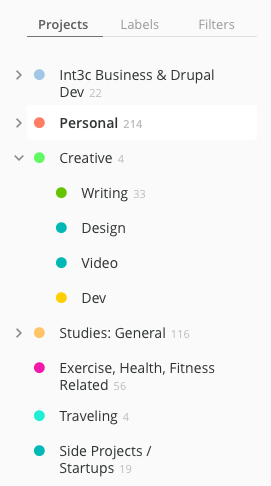
When it comes to implementing a GTD-inspired system, here are some steps to keep in mind:
Step 0: Create Projects” The first thing is to focus on creating projects to best organize what you are and will be working on. Projects in Todoist act like your main silos for areas you want to focus on. For example, I have a project for my Web Development business and then sub-projects for areas like Business Development, Misc Client Work and Projects for our main clients. I have projects for creative work, for exercise and for several others areas. After some tweaks and back and forth, I ended up with a total of around 25 to 30 projects.
Step 2: Create Any and All Tasks: The most important thing though is to get all of these tasks and goals out of your head and into a system. This is essence of “Getting Things Done” methodology. So you’ll want to do a series of mind dumps and get everything you need to do out of your head and into a system like Todoist. This should include emails and anything you can think of that should be “task-ified.” Whenever something pops in your head as a task just put it in Todoist. You can sort it later.
Step 2: Sort It and Schedule It: The next step with GTD (and Todoist) is to organize and priorize. Avoiding mixing your mind dump with your organizational step. Once tasks and projects are in Todoist you can organize and prioritize. You can move tasks into their related projects and group them into task groups. You can add priority tags so items show up in order. And if you see this as something needed on a schedule, then you can leverage one of Todoist’s best features to schedule that task for a certain day, week or month.
GTD encourages segmenting your productivity process into different focuses. Don’t try to do it all at once. That means clarifying, sorting and scheduling are separate from reviewing and doing.
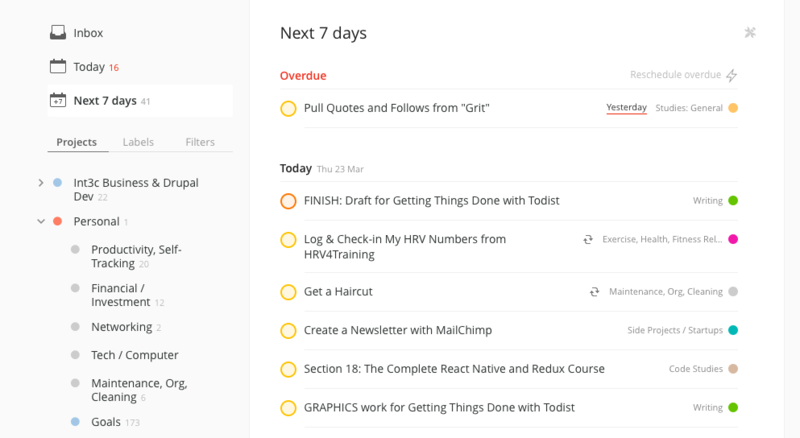
Step 3: Review Your Tasks and What’s Next: Once you have your tasks in Todoist and scheduled, you periodically need to review it. This means generally a daily check on what’s scheduled for today, tomorrow or this week. In my case I do this about 2 or 3 times per day. Once in the morning and again at the end of the day.
GTD also encourages a Weekly Review, which is when you have a block of time to process things, review how your system is going and reflect at a higher level.
Step 4: Choose and Execute: Allen calls this engaging with your work, and it boils down to work on your work. Now that you have a system that captures everything and a process to sort, prioritize and schedule, you can relax and focus on the work.
The goal of GTD with Todoist or any tool is to get the important stuff done. The aim is to achieve this while avoiding getting stressed about forgetting what you have to do. This is where GTD is a system for establishing where information, appointments and tasks are and providing periodic steps to sort, prioritize and schedule as well as higher altitude reviews.
Todoist makes this easier. It’s multiplatform so you can capture tasks anywhere. It’s GTD-inspired tagging and scheduled makes it clear what important tasks to do today and over a week, month or year. It can handle all forms of projects and tasks, so it’s searchable. It’s project views make it easy to visualize and sort your list of next steps. Its Today and 7 Day Views makes it clear what’s ahead in a manageable chunk.
Conclusion: Beyond “Getting Things Done,” Self-Tracking with Todoist
My main takeaway in adapting and leveraging GTD as the rules to how I work, create and live is that I have a lot of work but I rarely feel overworked. This transition happened by processing, prioritizing, scheduling and then working.
I rarely have to overthink about what’s my next main task. I know because I’ve either scheduled my time for something or its a key task in my upcoming agenda.
In this post, we did a pretty thorough review of David Allen’s productivity system “Getting Things Done.” We highlighted its five core tenants:
- Capture everything: From articles to questions to anything, develop a system to put information and tasks in their place.
- Clarify the Actionable Steps: Failing to state what you need to do in a certain area makes you anxious. So take unprocessed things and establish what the next step should be. For larger projects come up with several next steps
- Organize those actionable items by category and priority: Order those next actionable items by priority and schedule them. Todoist makes this easy. Once you do, suddenly a lot of uncertainty disappears. You may have to adjust the schedule but having it settled for now means you don’t have to worry about mentally.
- Reflect on your to-do list: A couple times a day check your calendar and todoist to see where things stand. Work requirements change so you may need to reschedule items or modify today’s priorities. That’s ok. Just ensure you are working towards completing the important stuff as well as the immediate stuff. And don’t forget to do weekly reviews too.
- Engage and get to work: Once your information is organized in accessible ways and your priority tasks are clarified, you can work in a state of zen. You don’t stress out about the tasks and projects since you know you’ve got a system for it. You can focus on the work.
I find GTD’s principles and way of thinking to be extremely helpful in organizing and executing on my priorities and projects. It does take a level of commitment. You need to slowly but surely close the gaps between a system to manage your information and tasks and what you keep in your head.
While GTD encourages certain behaviors and best practices, the final application needs to be your own. In my case, I’m almost entirely digital, so using tools like Evernote and Todoist makes the most sense.
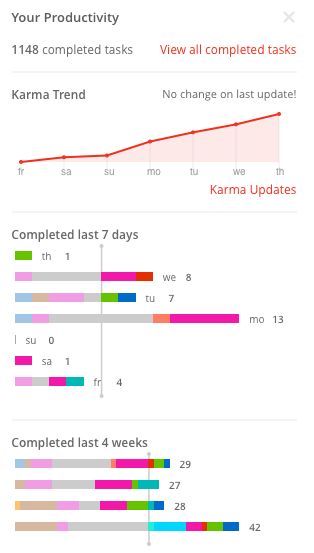
Along with becoming good at getting things done, Todoist opens up several avenues to explore just how well you to work. Quite simply Todoist tracks how many tasks you get done over periods and from which projects. You can get your overall completed tasks number for a day, week or overall. It then generates some nice charts to visualize it, and Todoist even has a gamification system called Karma that provides a bit of a push to keep you on-task more often.
Whether or not you are intersted in personal tracking, simple metrics like a daily goal of completed tasks is a good anchor for a productive life. By default, Todoist has a daily goal of five completed tasks.
Beyond its own internal system, the data around completed tasks in Todoist can be exported or integrated with other systems to further explore. In my case, I pull this data into a spreadsheet application. By looking at the data I noticed a tendency to fall into the checklist trap of completing lots of small tasks instead of bigger, harder tasks. We like checking off things and tend to procrastinate about more difficult and ill-defined projects.
By noticing this tendency, I’ve been able to adjust my process to focus more on higher priority tasks per day and per week. So, for me it’s not just about getting anything done, it’s about getting the important stuff done. Todoist data helped expose this realization.
Tracking and data analysis using Todoist is another topic to explore in part 2. For now, hopefully I’ve been able to expose enough of an overview of Getting Things Done and Todoist to get you started.
What productivity tools do you use? How are you leveraging them to work better and more productive? Share your thoughts in the comments.
